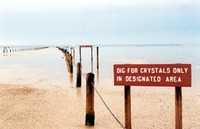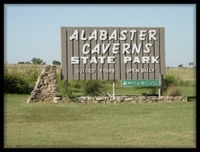
Rockhounding Oklahoma
Oklahoma is a good state for rockhounding. The state is noted for its unusual selenite crystals and its ‘barite roses.’ Previously, the northeastern portion of Oklahoma was noted for being part of the legendary Tri-State Mining District famed for its lead and zinc mines. Portions of Oklahoma (especially the southwest) are noted for agate, jasper, and petrified wood. Oklahoma also has a relatively rich fossil legacy including dinosaurs. The state also is home to a fabulous natural history museum with terrific exhibits for rockhounds.
State Rocks, Gemstones, Minerals, Fossils, & Dinosaurs
Rockhounding Tip: Knowing state rocks, gemstones, minerals, fossils, and dinosaurs often can be very useful information for rockhounders. Ordinarily, states with significant mineral deposits, valuable gemstones, fossils, or unusual or significant rock occurrences will designate an official state mineral, rock/stone, gemstone, fossil, or dinosaur to promote interest in the state’s natural resources, history, tourism, etc. Accordingly, such state symbols often are a valuable clue as to potential worthwhile rockhounding opportunities.

Barite Rose
State Rock: Barite Rose (1968)
Oklahoma designated
the Barite Rose (commonly known as the “rose rock”) as its official state rock
in 1968. Barite comes from the Greek
word barys, which means
heavy. Barite has a high specific
gravity (4.5 when 2-3 is more typical for a non-metallic mineral). Barite forms in sedimentary environments
commonly as cement in sandstones. Barite
roses are twinned crystals of barite that resemble an open rose and are colored
reddish-brown by oxidized iron. Barite
roses (or Rose rock) resemble rose flowers and was formed by barite rock crystals
during the Permian Age. Barite roses are
found in a few rare places around the globe.
In Oklahoma, the distinctive red soil colors them in hues ranging from
reddish brown to cinnamon. Barite roses
are relatively abundant in central Oklahoma. The unusual form, ease of
collection, and local color of barite rosettes have made them popular with rock
and mineral collectors. The town of Noble, where rose rocks are often found, is
now home to a privately run Rose Rock Museum and an annual Rose Rock Festival.

Saurophaganax maximus
State
Fossil: Saurophaganax maximus (2000)
Oklahoma designated Saurophaganax maximus as its official
state fossil in 2000. This large, fierce,
carnivorous theropod roamed the plains of the state during the Jurassic Period,
about 150 million years ago, preying on smaller dinosaurs. It grew to a length of forty feet and probably
stood around sixteen feet high. Saurophaganax comes from the Morrison
Formation, a rock unit that is widely exposed in the western states and
represents a lowland environment dotted with lakes and streams. Many different dinosaurs are found in this
rock unit, including allosaurs, stegosaurs and apatosaurus, but as yet, Saurophaganax has only been found in
Oklahoma. In fact, Saurophaganax so resembles a large Allosaurus that there is some debate
about its proper taxonomic position. The
first bones of Saurophaganax
were found in the late 1930s by a WPA crew under the supervision of a University
of Oklahoma paleontologist.

Acrocanthosaurus atokensis
State
Dinosaur: Acrocanthosaurus
atokensis (2006)
Oklahoma designated Acrocanthosaurus atokensis as its official state dinosaur in 2006. In the
Early to Mid-Cretaceous Period (125 to 100 million years ago), large
meat-eating dinosaurs roamed the flat muddy shoreline that is now southeastern
Oklahoma. Among these dinosaurs was Acrocanthosaurus atokensis, whose
name means “high-spined lizard.” This
dinosaur lived about 45 million years before the reign of Tyrannosaurus rex,
and is the largest meat eating dinosaur from that era to have been discovered
in North America. Its two outstanding
characteristics are the long spines on its back, and the three claws reaching
out from each forelimb. The claws of Acrocanthosaurus atokensis measure up
to six inches in length and are well designed for capturing and holding prey,
and for tearing flesh from bone.

Hourglass Selenite Crystal
State Crystal: Hourglass Selenite (2005)
Oklahoma also has designated
an official state crystal. Oklahoma designated
the hourglass selenite crystal as its official state crystal in 2005. Hourglass selenite is a crystallized variety
of gypsum. Hourglass selenite is common
to the ancient salt plains in north central Oklahoma and this is the only place
this variety occurs.
Rockhounding Resources

State-specific rockhounding books (including the books listed here as well as other books), regional rockhounding site guides, and other helpful rockhounding resources are identified - by category - in the Books & Gear section of Gator Girl Rocks with a link to the Gator Girl Rocks Amazon Store where you may easily browse selected resources and securely place an order. Your order will benefit Charity Rocks!

Oklahoma Geological Survey
The Oklahoma Geological Survey has a variety of
useful resources, including its
publications titled Oklahoma Rocks, Petrified Wood in
Oklahoma, and The Barite Roses of Oklahoma.
Oklahoma Paleontological Society
- E.L. Gilmore, Minerals of Oklahoma: A Rockhound’s Guide to the Gems & Minerals of Oklahoma (1963).
- George P. Hansen, Trilobites of Black Cat Mountain (2009).
- June Culp Zeitner, Southwest Mineral & Gem Trails (1972).
- Allan W. Eckert, Earth Treasures Vol. 4B - Southwestern Quadrant (1987; reprint in 2000).
- James Martin Monaco & Jeannette Hathway Monaco, Fee Mining & Rockhounding Adventures in the West (2d ed. 2007).
- Kathy J. Rygle & Stephen F. Pedersen, Southwest Treasure Hunter's Gem & Mineral Guide (4th ed. 2008).
Museums of Interest to Rockhounders

Sam Noble Oklahoma
Museum of Natural History
Norman, Oklahoma
Sam Noble is one of the world's largest
university-based natural history museums.
The museum's exhibits include, among other things, fossils and dinosaur
skeletons from Oklahoma and throughout the world. Exhibits include the world's largest
Apatosaurus skeleton, a Pentaceratops skeleton with a skull 3.1 almost ten feet
high (the largest known of a land vertebrate).
The museum’s Hall of Ancient Life depicts four billion years of
Oklahoma’s prehistory. A ride in the museum's glass "dinovators"
gives visitors an opportunity to see the Apatosaurus
eye to eye.

Museum of the Red River
Idabel, Oklahoma
The Museum of the Red River exhibits a cast of
‘McCurtain County’s dinosaur’ – the Acrocanthosaurus atokensis that was discovered in McCurtain County, Oklahoma.
Elsing Museum
Oral Roberts University – Tulsa, Oklahoma
The museum exhibits rocks, minerals, gems, and
fossils including many from the famed Tri-State Mining District.

Midgley Museum (Rock House)
Enid, Oklahoma
This unique museum was the home of Dan and Libby Midgley. The Midgleys planned the house and collected
the rocks, fossils, and petrified wood that make up the exterior walls and
interior fireplaces of the museum. There
are thirty-four different kinds of stones used in the building. These stones
were collected in Oklahoma, Texas, New Mexico, and Arkansas. Most of these
rocks and fossils were found near Lake Texoma. The enormous stump at the front
of the house near the street is fossilized redwood it was found near Woodward
Oklahoma.
Places to Visit - Interesting Sites To See

Salt Plains National Wildlife Refuge
Jet, Oklahoma
The Salt Plains National Wildlife Refuge
includes the largest saline flat in the
central lowlands of North America (approximately 10,000 acres). The salt plains are a unique geological
area. It is near perfectly flat with a
wafer thin salt crust. The salt was
formed by repeated seawater flooding millions of years ago. The seawater was cut off from the sea and
evaporated, depositing thick layers of salt.
The area was subsequently covered by erosion from mountain ranges. Below the plains, ground water travels
through the salt-saturated sand and comes to the surface where it evaporates,
leaving the crust of salt. The
concentrated saline solution combines with gypsum to promote selenite crystal
growth in a portion of the salt flats. Selenite
is a crystallized form of gypsum.
Chemically, it is a hydrous calcium sulfate. Gypsum is a common mineral that takes on a
great variety of crystal forms and shapes.
On the Salt Plains, the crystals are formed just below the salt
encrusted surface. They are seldom found
deeper than two feet below the surface. Crystals
take on the characteristics of their environment; the finer the soil, the more
clear the crystals. Iron oxide in the
soil gives the crystals their chocolate brown color.

Black Mesa
Northwest Oklahoma – Cimarron County, Oklahoma
During the ‘Age of the Dinosaurs’ – the
Mesozoic Era – about 65 million to 250 million years ago, Oklahoma was home for
dinosaurs and other creatures. There is
a dinosaur trackway in the Morrison Formation (sandstone) near Kenton. Note:
This site is on private property.

Alabaster Caverns State Park
Freedom, Oklahoma
The highlight of this 200-acre park is the
3/4-mile cavern formed of alabaster, a form of gypsum, making it the largest
natural gypsum cave in the world open to the public.

Picher Mining District / Ghost Town
Ottawa County, Oklahoma
The Picher area is a superfund site. Previously, it was the most productive lead-zinc mining field in the
Tri-State district producing over $20 billion worth of ore between 1917 and
1947. More than fifty percent of the
lead and zinc metal used during World War I were produced by the Picher
district. At its peak over 14,000 miners
worked the mines and another 4,000 worked in mining services. Many of these workers commuted by an
extensive trolley system from as far away as Joplin and Carthage,
Missouri. Mining ceased in 1967 and
water pumping from the mines ceased. The
contaminated water from some 14,000 abandoned mine shafts, 70 million tons of
mine tailings, and 36 million tons of mill sand and sludge remained as a huge
environmental cleanup problem. The area became part of the Tar Creek Superfund
site. Following a mandatory evacuation,
and an F4 tornado, the town officially ceased to exist in 2009. There used to
be a museum that focused on the boom and bust of the largest lead and zinc
mining field in the world.
Rockhounding Sites for Children & Families

Selenite Crystals
Salt Plains National Wildlife Refuge – West of Jet,
Oklahoma
Although specimen
collecting generally is prohibited in National Wildlife Refuges, recreational
rockhounders are permitted (subject to federal restrictions) to collect
selenite crystals at the Salt Plains National Wildlife Refuge (April 1 –
October 15). Single crystals, penetration twins, and clusters are
the typical crystal shapes most frequently encountered on the refuge. Exceptional individual crystals measuring up
to seven inches long have been found, along with complex combinations weighing
as much as 38 pounds. Collectors are
permitted to remove up to 10 pounds of crystals plus one large cluster for
their personal use in any one day. It is
unlawful to sell crystals taken from the refuge.
